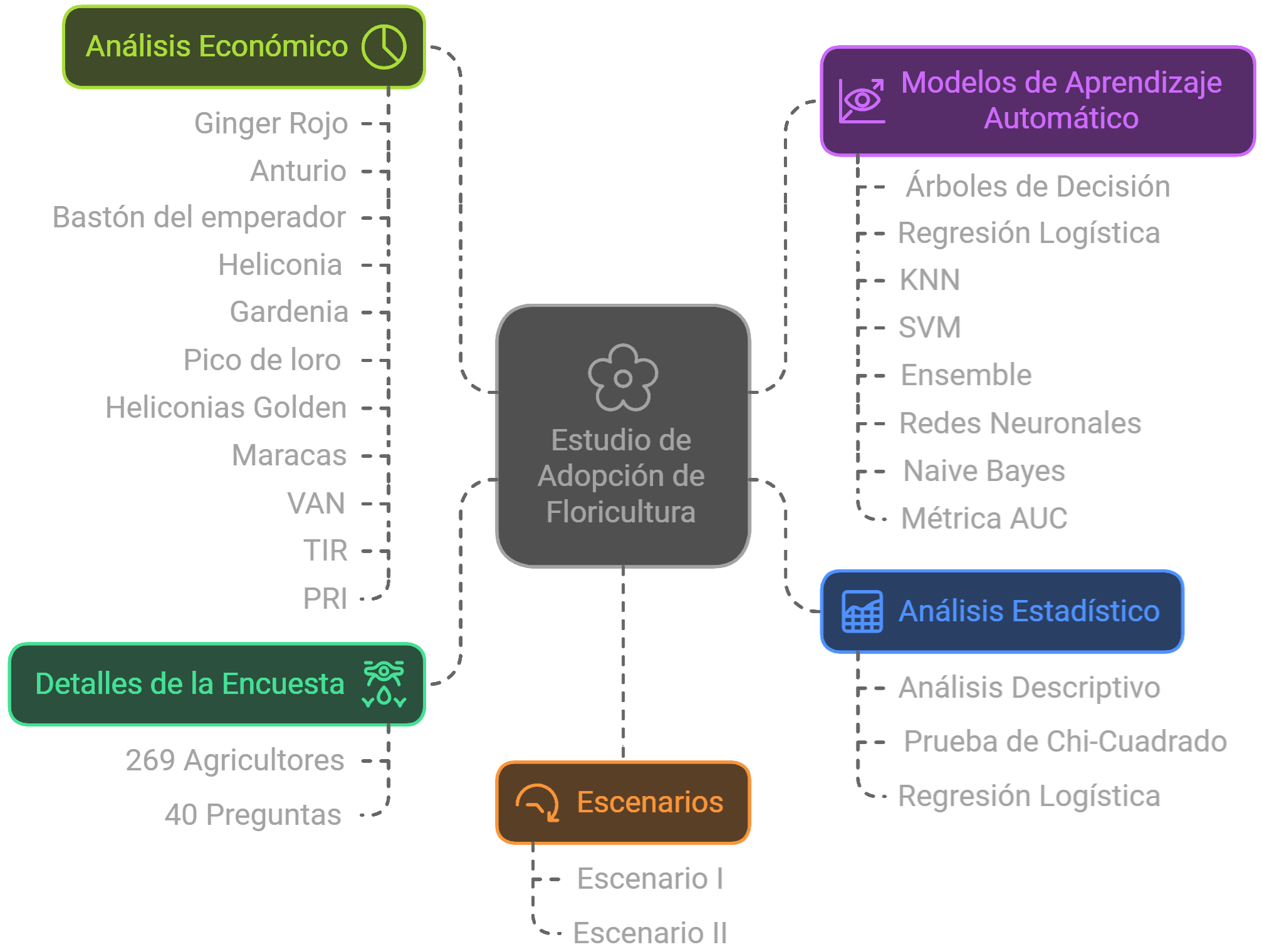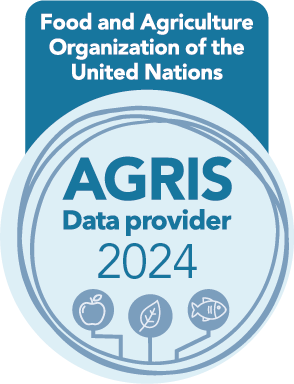The floriculture as an alternative crop: Descriptive analysis, artificial intelligence modeling, scenario analysis and economic analysis
DOI:
https://doi.org/10.17268/sci.agropecu.2025.003Keywords:
Floriculture, economic analysis, alternative crop, artificial intelligence, biodiversity, sustainability, fair tradeAbstract
Floriculture is a sector of growing global importance, contributing to employment generation, income creation, and the promotion of biodiversity and sustainability. This study aimed to identify the factors influencing the adoption of floriculture as an alternative crop in the province of Leoncio Prado, Peru, and to assess its economic viability. A total of 269 farmers were surveyed, analyzing attitudes, land suitability, and socioeconomic and environmental factors. Influential factors were identified using descriptive analysis, chi-square tests, and logistic regression (p < 0.1). Additionally, multiple machine learning algorithms (Decision Trees, Logistic Regression, KNN, SVM, Ensemble, Neural Networks, Naive Bayes) with cross-validation (k = 5) and AUC metrics were employed to model adoption intentions. Scenarios were developed to increase the willingness to adopt floriculture, and an economic analysis of eight tropical species (Red Ginger, Anthurium, Emperor's Staff, Heliconia, Gardenia, Parrot's Beak, Golden Heliconias, Maracas) was conducted. The results reveal that willingness to change crops, participation in awareness campaigns, allocation of areas for conservation, and cost control are key factors. The neural network model achieved an AUC of 83.3%, and improved scenarios indicate that adoption could increase by up to 11.32%. Red Ginger demonstrated high profitability (NPV S/10428; IRR 51%; PBP 0.7 years). In conclusion, floriculture represents an economically and environmentally viable alternative that contributes to agricultural diversification and sustainability.
References
Afonso, M., Paulo, M.-J., Fonteijn, H., van den Helder, M., Zwinkels, H., Rijsbergen, M., et al. (2024). Automatic trait estimation in floriculture using computer vision and deep learning. Smart Agricultural Technology, 7. https://doi.org/10.1016/j.atech.2023.100383
Alavi-Murillo, G., Diels, J., Gilles, J., & Willems, P. (2022). Soil organic carbon in Andean high-mountain ecosystems: importance, challenges, and opportunities for carbon sequestration. Regional Environmental Change, 22(4), 128. https://doi.org/10.1007/s10113-022-01980-6
Blare, T., & Donovan, J. (2018). Building value chains for indigenous fruits: lessons from camu-camu in Peru. Renewable Agriculture and Food Systems, 33(1), 6–18. https://doi.org/10.1017/S1742170516000181
Chabalala, Y., Adam, E., & Ali, K. A. (2023). Exploring the Effect of Balanced and Imbalanced Multi-Class Distribution Data and Sampling Techniques on Fruit-Tree Crop Classification Using Different Machine Learning Classifiers. Geomatics 2023, Vol. 3, Pages 70-92, 3(1), 70–92. https://doi.org/10.3390/GEOMATICS3010004
De Pascale, S., & Romano, D. (2019). Potential use of wild plants in floriculture. Acta Horticulturae, 1240, 87–98. https://doi.org/10.17660/ACTAHORTIC.2019.1240.15
Devaux, A., Torero, M., Donovan, J., & Horton, D. (2018). Agricultural innovation and inclusive value-chain development: a review. Journal of Agribusiness in Developing and Emerging Economies, 8(1), 99–123. https://doi.org/10.1108/JADEE-06-2017-0065
Ellis, R. E. (2016). The Evolving Transnational Crime-Terrorism Nexus in Peru and its Strategic Relevance for the U.S. and the Region. PRISM, 5(4), 188–205. http://www.jstor.org/stable/26459220
Eyhorn, F., Muller, A., Reganold, J. P., Frison, E., Herren, H. R., Luttikholt, L., et al. (2019). Sustainability in global agriculture driven by organic farming. Nature Sustainability, 2(4), 253–255. https://doi.org/10.1038/s41893-019-0266-6
Farooqui, N. A., & Ritika. (2020). A Machine Learning Approach to Simulating Farmers’ Crop Choices for Drought Prone Areas. Lecture Notes in Electrical Engineering, 605, 472–481. https://doi.org/10.1007/978-3-030-30577-2_41
Garcia-Yi, J. (2014). Heterogeneous motivations for coca growing: The case of an indigenous Aymara community in Peru. International Journal of Drug Policy, 25(6), 1113–1123. https://doi.org/10.1016/J.DRUGPO.2014.05.011
Gomiero, T., Pimentel, D., & Paoletti, M. G. (2011). Is There a Need for a More Sustainable Agriculture? Critical Reviews in Plant Sciences, 30(1–2), 6–23. https://doi.org/10.1080/07352689.2011.553515
Graskemper, V., Yu, X., & Feil, J. H. (2021). Farmer typology and implications for policy design – An unsupervised machine learning approach. Land Use Policy, 103, 105328. https://doi.org/10.1016/J.LANDUSEPOL.2021.105328
Hall, T. J., Dennis, J. H., Lopez, R. G., & Marshall, M. I. (2009). Factors Affecting Growers’ Willingness to Adopt Sustainable Floriculture Practices. HortScience, 44(5), 1346–1351. https://doi.org/10.21273/HORTSCI.44.5.1346
Jezeer, R. E., Verweij, P. A., Boot, R. G. A., Junginger, M., & Santos, M. J. (2019). Influence of livelihood assets, experienced shocks and perceived risks on smallholder coffee farming practices in Peru. Journal of Environmental Management, 242, 496–506. https://doi.org/10.1016/J.JENVMAN.2019.04.101
Jula, G., Kim, D.-G., & Nigatu, S. (2024). Potential of floriculture waste-derived charcoal briquettes as an alternative energy source and means of mitigating indoor air pollution in Ethiopia. Energy for Sustainable Development, 79. https://doi.org/10.1016/j.esd.2024.101390
Junqueira, A. H., & Peetz, M. da S. (2018). Sustainability in Brazilian floriculture: introductory notes to a systemic approach. Ornamental Horticulture, 24(2), 155–162. https://doi.org/10.14295/OH.V24I2.1253
Kremen, C., Williams, N. M., Aizen, M. A., Gemmill-Herren, B., LeBuhn, G., Minckley, R., et al. (2007). Pollination and other ecosystem services produced by mobile organisms: a conceptual framework for the effects of land-use change. Ecology Letters, 10(4), 299–314. https://doi.org/https://doi.org/10.1111/j.1461-0248.2007.01018.x
Li, Y., & Dong, X. (2023). A RUSBoosted tree method for k-complex detection using tunable Q-factor wavelet transform and multi-domain feature extraction. Frontiers in Neuroscience, 17, 1108059. https://doi.org/10.3389/FNINS.2023.1108059
Manikas, I., Malindretos, G., & Abeliotis, K. (2020). Sustainable Cities through Alternative Urban Farming: The Case of Floriculture. Journal of International Food & Agribusiness Marketing, 32(3), 295–311. https://doi.org/10.1080/08974438.2019.1599762
Morales, E. (1986). Coca and Cocaine Economy and Social Change in the Andes of Peru. Economic Development and Cultural Change, 35(1), 143–161. https://doi.org/10.1086/451575
Phondani, P. C., Bhatt, I. D., Maikhuri, R. K., Kothyari, B. P., Bhatt, A., Purohit, V. K., & Joshi, P. (2019). Exploring Floriculture Potential for Sustainable Livelihood of Subsistence Communities in Indian Himalaya. National Academy Science Letters, 42(1), 39–44. https://doi.org/10.1007/S40009-018-0660-Z
Romero, D. B. C., Estrella, Y. G. M., Laureano, M. I. Z., Parejas, R. Á. R., & Quispe, J. A. D. (2022). A machine learning approach to find the determinants of Peruvian coca illegal crops. Decision Science Letters, 11(2), 127–136. https://doi.org/10.5267/J.DSL.2021.12.003
Sahu, D., Sahu, J. K., Kumar, V., & Gupta, P. (2023). Role of Floriculture in Promoting Biodiversity and Enhancing Ecosystems: A Comprehensive Review. International Journal of Environment and Climate Change, 13(9), 2077–2084. https://doi.org/10.9734/IJECC/2023/V13I92439
Schelleman-Offermans, K., Dito, B. B., Gudeta, K. H., Fourie, E., Kebede, S. W., Mazzucato, V., & Jonas, K. J. (2024). Socio-economic inequities in mental health problems and wellbeing among women working in the apparel and floriculture sectors: testing the mediating role of psychological capital, social support and tangible assets. BMC Public Health, 24(1157). https://doi.org/10.1186/s12889-024-18678-5
Schumacher, S. K., & Marsh, T. L. (2003). Economies of Scale in the Floriculture Industry. Journal of Agricultural and Applied Economics, 35(3), 497–507. https://doi.org/10.1017/S1074070800028236
Tobin, D., Bates, R., Brennan, M., & Gill, T. (2018). Peru potato potential: Biodiversity conservation and value chain development. Renewable Agriculture and Food Systems, 33(1), 19–32. https://doi.org/10.1017/S1742170516000284
Tobin, D., & Glenna, L. (2019). Value Chain Development and the Agrarian Question: Actor Perspectives on Native Potato Production in the Highlands of Peru. Rural Sociology, 84(3), 541–568. https://doi.org/10.1111/RUSO.12251
van Dun, M. (2019). Narco-Territoriality and Shadow Powers in a Peruvian Cocaine Frontier. Terrorism and Political Violence, 31(5), 1026–1048. https://doi.org/10.1080/09546553.2017.1309392
Wani, M. A., Nazki, I. T., Din, A., Iqbal, S., Wani, S. A., Khan, F. U., & Neelofar. (2018). Floriculture Sustainability Initiative: The Dawn of New Era. In E. Lichtfouse (Ed.), Sustainable Agriculture Reviews 27 (pp. 91–127). Springer International Publishing. https://doi.org/10.1007/978-3-319-75190-0_4

Published
How to Cite
Issue
Section
License
Copyright (c) 2025 Scientia Agropecuaria

This work is licensed under a Creative Commons Attribution-NonCommercial 4.0 International License.
The authors who publish in this journal accept the following conditions:
a. The authors retain the copyright and assign to the magazine the right of the first publication, with the work registered with the Creative Commons attribution license, which allows third parties to use the published information whenever they mention the authorship of the work and the First publication in this journal.
b. Authors may make other independent and additional contractual arrangements for non-exclusive distribution of the version of the article published in this journal (eg, include it in an institutional repository or publish it in a book) as long as it clearly indicates that the work Was first published in this journal.
c. Authors are encouraged to publish their work on the Internet (for example, on institutional or personal pages) before and during the review and publication process, as it can lead to productive exchanges and a greater and faster dissemination of work Published (see The Effect of Open Access).




